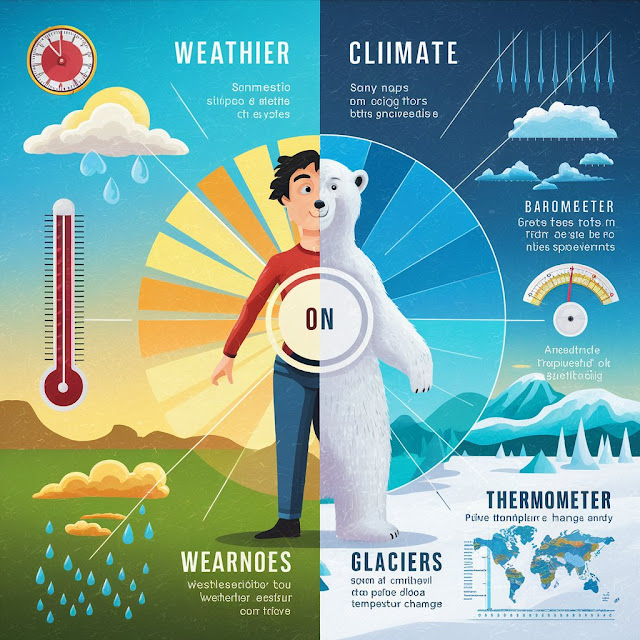What is the difference between weather and climate ? with example
What is the difference between weather and climate ? with example
 |
| What is the difference between weather and climate ? with example |
Weather and climate are related but distinct concepts:
1. Weather:
- Weather refers to the atmospheric conditions in a specific place at a specific time. It includes factors such as temperature, humidity, precipitation, wind speed, and atmospheric pressure.
- Weather is short-term and can change rapidly, often from day to day or even within hours.
- Examples of weather include sunny, rainy, cloudy, windy, or snowy conditions experienced on a particular day.
2. Climate:
- Climate refers to the long-term patterns and averages of weather conditions in a particular region over a long period of time, typically averaging over at least 30 years.
- Climate encompasses factors such as average temperature, precipitation levels, humidity, and seasonal variations.
- Climate provides a broader picture of the typical weather patterns and conditions experienced in a region over an extended period.
- Climate can influence the types of ecosystems present, the distribution of plant and animal species, and human activities such as agriculture, urban planning, and resource management.
- Climate change refers to significant and lasting changes in these long-term patterns of temperature, precipitation, and other climate variables, often attributed to human activities such as the burning of fossil fuels and deforestation.
weather and climate with an example:
Example: New York City
- Weather:
- Today in New York City, the temperature is 70°F (21°C), with partly cloudy skies and a slight chance of afternoon showers. The wind speed is 10 mph, and humidity is around 50%. This describes the current atmospheric conditions in the city at this moment.
- Climate:
- The climate of New York City is characterized by four distinct seasons: spring, summer, fall, and winter.
- On average, during the summer months (June to August), temperatures range from 70°F to 85°F (21°C to 29°C), with occasional heatwaves pushing temperatures higher. Precipitation levels are moderate, with occasional thunderstorms.
- In contrast, during the winter months (December to February), temperatures typically range from 25°F to 40°F (-4°C to 4°C), with occasional snowfall and cold Arctic air masses bringing freezing temperatures.
- Over the long term, New York City experiences a humid subtropical climate, influenced by its proximity to the Atlantic Ocean and the presence of the Appalachian Mountains to the west. This climate pattern determines the city's typical weather patterns and seasonal variations over many years.